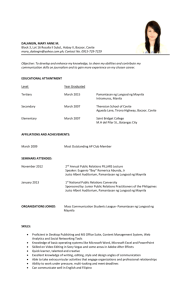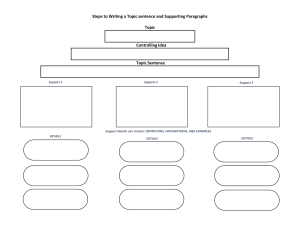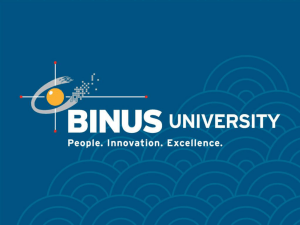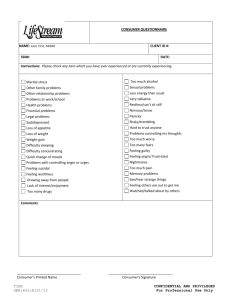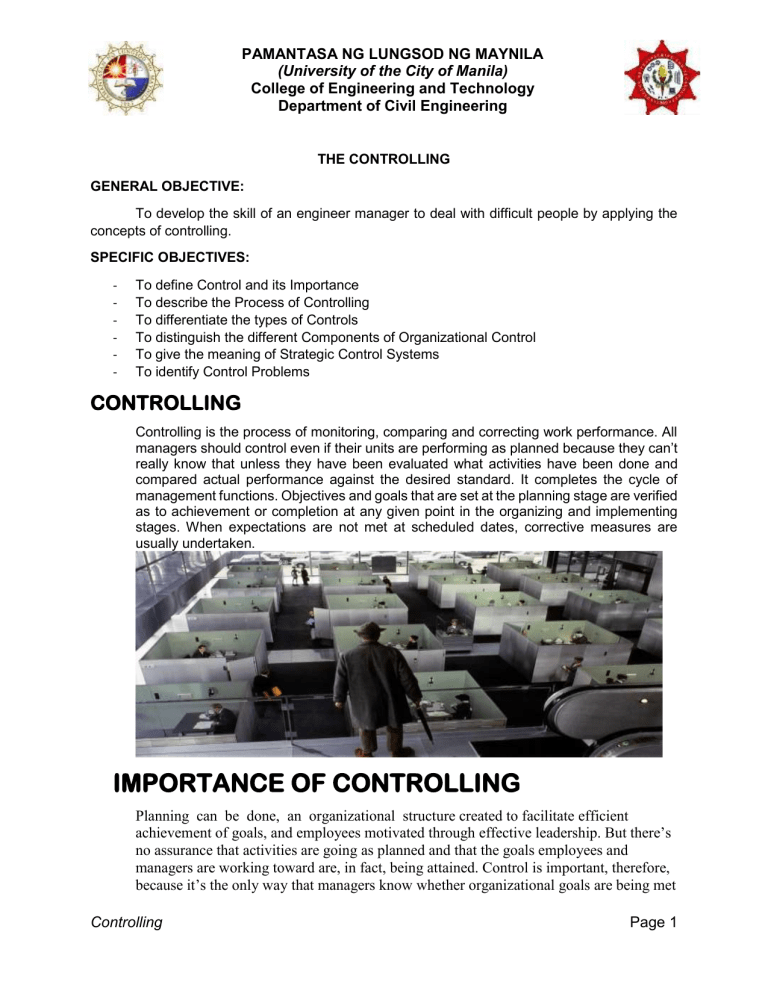
PAMANTASA NG LUNGSOD NG MAYNILA (University of the City of Manila) College of Engineering and Technology Department of Civil Engineering THE CONTROLLING GENERAL OBJECTIVE: To develop the skill of an engineer manager to deal with difficult people by applying the concepts of controlling. SPECIFIC OBJECTIVES: - To define Control and its Importance To describe the Process of Controlling To differentiate the types of Controls To distinguish the different Components of Organizational Control To give the meaning of Strategic Control Systems To identify Control Problems CONTROLLING Controlling is the process of monitoring, comparing and correcting work performance. All managers should control even if their units are performing as planned because they can’t really know that unless they have been evaluated what activities have been done and compared actual performance against the desired standard. It completes the cycle of management functions. Objectives and goals that are set at the planning stage are verified as to achievement or completion at any given point in the organizing and implementing stages. When expectations are not met at scheduled dates, corrective measures are usually undertaken. IMPORTANCE OF CONTROLLING Planning can be done, an organizational structure created to facilitate efficient achievement of goals, and employees motivated through effective leadership. But there’s no assurance that activities are going as planned and that the goals employees and managers are working toward are, in fact, being attained. Control is important, therefore, because it’s the only way that managers know whether organizational goals are being met Controlling Page 1 PAMANTASA NG LUNGSOD NG MAYNILA (University of the City of Manila) College of Engineering and Technology Department of Civil Engineering - and, if not, the reasons why. The value of the control function can be seen in three specific areas: planning, empowering employees, and protecting the workplace. The importance of controlling may be illustrated as it is applied in a typical factory. If the required standard daily output for individual workers is 100 pieces, all workers who do not produce the requirement are given sufficient time to improve; if no improvements are forthcoming, they are asked to resign. This action will help the company keep its overhead and other costs at expected levels if no such control is made, the company will be faced with escalating production costs, which will place I ho viab11ity of the firm in jeopardy. TYPES OF CONTROL There are three known types of control models which named as the following: 1. Feedforward Control 2. Concurrent Control 3. Feedback Control PRE-OPERATIONS PHASE FEEDFORWARD CONTROL ACTUAL OPERATIONS PHASE CONCURRENT CONTROL POST OPERATIONS PHASE FEEDBACK CONTROL FEEDFORWARD CONTROL Most desirable type of control—feedforward control—prevents problems because it takes place before the actual activity. Sometimes called preliminary or preventive control. Its purpose is to ensure that input quality is high enough to prevent problems when the organization perform its tasks. Controlling Page 2 PAMANTASA NG LUNGSOD NG MAYNILA (University of the City of Manila) College of Engineering and Technology Department of Civil Engineering Feedforward control is evident in the selection and hiring of new employees. Organizations attempt to improve the likelihood that employees will perform up to standards by identifying the necessary skills and using tests and other screening devices to hire people who have those skills. Feedforward Controls allow management to prevent problems rather than having to cure them later. For example, Engineer Managers in Engrudite Company may hire additional engineers as soon as the government announces that the firm has won a major defense contract. The hiring of personnel ahead of time prevents potential delays therefore the managerial department taking an action before the problem occurs. Another purpose of feedforward control is to identify and manage risks. Large accounting firms have recognized they can offer value to their clients by looking for risks the clients have knowingly or unknowingly taken on, rather than merely evaluating their financial performance after the fact. For example, an auditing firm developed methods such as to study a client’s industry, strategy, and operations to identify key business risks not shown on typical financial statements. In conducting such an audit for an Asian client, the firm learned that the company was preparing to enter a contract to buy natural gas futures without sufficiently protecting itself against sudden shifts in the price of natural gas. A sudden change in gas prices could have forced the company to buy at an excessive price, costing it as much as a year earnings. But because the problem was identified ahead of time, the client was able to protect itself from this potential loss. CONCURRENT CONTROL This takes place while an activity is in progress. When this is enacted while the work is being performed, management can correct problems before they come too costly. Concurrent control consists primarily of actions by supervisors who direct the work of their subordinates. This monitors ongoing employee activities to ensure they are consistent with quality standards. Concurrent Control assesses current work activities, relies on performance standards, and includes rules and regulations for guiding employee tasks and behaviors. Its intent is to ensure that work activities produce the correct results. It includes self-control, through which individuals impose concurrent control on their own behavior. Many manufacturing operations include devices that measure whether the items being produced meet quality standards. Employees monitor the measurements; if they see that standards are not met in some area, they make a correction themselves or signal appropriate person that a problem is occurring. Technology advancements are adding to the possibilities for concurrent control in services as well. For example, nearly three-fourths of major U.S trucking companies use computers to help plan their routes for efficiency. And almost two-thirds employ electronic devices that monitor truckers’ Controlling Page 3 PAMANTASA NG LUNGSOD NG MAYNILA (University of the City of Manila) College of Engineering and Technology Department of Civil Engineering activities using satellites to beam data back to headquarters. Other concurrent controls involve the ways in which organizations influence employees. The best-known form of concurrent control is direct supervision also known as management by walking around which is when a manager is in the work area interacting directly with employees. Direction refers to the acts managers undertake (1) to instruct subordinates in the proper methods and procedures and (2) to oversee the work of subordinates to ensure that it is properly done. The relative importance of direction depends almost entirely on the nature of the tasks performed by subordinates. Another example is when an engineer spends a large portion of his workweek on the road talking to employees and visiting numerous sites. FEEDBACK CONTROL The most popular type of control which takes place after the activity is done. The major drawback of this control is that by the time the manager has the information the damage has already been done. Sometimes called post-action or output control which focuses on organization’s outputs---particularly the quality of an end-product or service. An example is the intensive final inspection of a refrigerator at a at a General Electric assembly plant. In Kentucky, school administrators conduct feedback control by evaluating each school’s performance every other year. They review reports of students’ scores on an annual test featuring essay questions about core subjects, as well as the school’s dropout and attendance rates. The state rewards schools with rising scores and brings in consultants to work with schools whose scores have fallen. Besides producing high quality products and services, businesses need to earn a profit, and even non-profit organizations need to operate efficiently to carry out their mission. Therefore, many feedback controls focus on financial measurements. For example, a firm’s financial statement can be used to determine if changes should be made in future resource acquisitions or operational activities. There are 3 feedback methods are widely used namely as: Financial Statement Analysis, Controlling Page 4 PAMANTASA NG LUNGSOD NG MAYNILA (University of the City of Manila) College of Engineering and Technology Department of Civil Engineering Standard Cost Analysis, Performance Evaluation. (1) and Employee’s Financial Statement Analysis A firm’s accounting system is a principal source of information from which managers receive financial statements. Periodically, managers receive financial statements, which include a balance sheet, an income statement, and a sources-and-uses-of-funds statement. These statements summarize and classify the effects of transactions in terms of assets, liabilities, equity, revenues, and expenses--the principal components of the firm’s financial structure. (2) Standard Cost Analysis Standard Cost Accounting Systems are a major contribution of scientific management. A standard cost system provides information that enables management to compare actual costs which identifies what corrective action the management must do. The first uses of standard cost accounting were concerned with manufacturing costs. (3) Employee’s Performance Evaluation Good performance evaluation is important because people are the most crucial resource in any organization. Effective businesses firms, hospitals, universities, and governments must have people who are effectively performing their assigned duties. Evaluating individual or group performance can be very difficult, however, because the standards for performance seldom are objective and straightforward. Furthermore, many managerial and non-managerial jobs do not produce outputs that can be counted, weighted, and evaluated in objective terms. Controlling Page 5 PAMANTASA NG LUNGSOD NG MAYNILA (University of the City of Manila) College of Engineering and Technology Department of Civil Engineering COMPONENTS OF ORGANIZATIONAL CONTROL SYSTEMS Organizational Control Systems has 6 important components namely as the following: 1. Strategic Plan 2. The Long-Range Financial Plan 3. The Operating Budget 4. Performance Appraisals 5. Statistical Reports 6. Policies and Procedures STRATEGIC PLANS This provides the basic control mechanism for the organization. When there are indications that activities do not facilitate the accomplishment of strategic goals, these activities are either set aside, modified or expanded. These corrective measures are made possible with the adoption of strategic plans. Controlling Page 6 PAMANTASA NG LUNGSOD NG MAYNILA (University of the City of Manila) College of Engineering and Technology Department of Civil Engineering THE LONG-RANGE FINANACIAL PLAN The financial oplan reccommends a direction for financial activities. If the goal does not appear to be where the firm is headed, the control mechanism should be made to work. Long term financial planning combines financial forecasting with strategizing. It is highly collaborative process that considers future scenarios and helps governments naviagte challenges. Long-term financial planning works best as a part of an overall strategic plan. Financial forecasting is the process of projecting revenues and expenditures over a longterm period, using assumptions about economic conditions, future spending scenarios, and other salient variables. Long-term financial planning is also the process of aligning financial capacity with longterm service objectives. Financial planning uses forecasts to provide insight into future finanacial capacity so that strategies can be developed to achieve long-term sustainability in light of the firm’s service objectives and financial challenges. A long-term financial plan should include these elements: 1. TIME HORIZON – A plan should look atleast five to ten years into the future. The firms may elect to extend their planning horizon further if conditions warrant. 2. SCOPE – A plan should consider all appropriated funds, but especially those funds that are used to account for the issues of top concern to elected officials and the community. 3. FREQUENCY – A plan should be updated with the long-term planning activities needed in order to provide direction to the budget process, though not every element of the long-range plan must be repeated. 4. CONTENT – A plan should include analysis of the financial environment, revenue and expenditure forecasts, debt position and affordanility analysis of key indicators of financial health. 5. VISIBILITY – Every departments of the firm should be able to easily learn about the long-term financial prospects of the companhy for financial balance. Hence, the company should devise an effective means for communicating this information, through either separate plan documents or by intergrating it with existing communication devices. Controlling Page 7 PAMANTASA NG LUNGSOD NG MAYNILA (University of the City of Manila) College of Engineering and Technology Department of Civil Engineering OPERATING BUDGET An operating budget indicates the expenditures, revenues, orprofits planned for some future period regarding operations. Companies use a master budget to manage their cash and other assets, and to estimate their future sales and expenses. Master budgets are made up of two parts that work together: financial budgets and operating budgets. Financial budgets focus on cash and capital expenditures. They are used to make sure that the business has the cash it needs to fund its operations and to maintain and/or upgrade its buildings and equipment. Once budgets are in place, companies can use them to manage activities, compare how they are earning or spending against these budgets, and prepare for future business cycles. The figures appearing in the budget are used as standard measurements for performance. PERFORMANCE APPRAISALS Controlling Page 8 PAMANTASA NG LUNGSOD NG MAYNILA (University of the City of Manila) College of Engineering and Technology Department of Civil Engineering Performance appraisal measures employee performance. As such, it provides employees with a guide on how to do their jobs better in the future. Performance appraisals also function as effective checks on new policies and programs. It is also known as an “Annual Review”, “Performance Review or Evaluation”, or “Employee Appraisal” wherein it evaluates an employee’s skills, achievements, and growth, or lack thereof. STATISTICAL REPORTS Statistical reports pertain to those that contain data on various developments within the firm. It is an organized synthesis of data that span a whole array of forms going from tables of numbers to a text summarizing the findings. Statistical reports are particularly interesting because the reader can easily be overwhelmed by the raw data. These are information which may be found in a statistical report: 1. 2. 3. 4. 5. 6. 7. Labor efficiency rates Quality control rejects Accounts receivable Accounts payable Sales reports Accident reports Power consumption report POLICIES AND PROCEDURES Policies refer to the “framework within which the objectives must be pursued”. A Procedure is “a plan that describes the exact series of actions to be taken in a given situation. A set of policies are principles, rules, and guidelines formulated or adopted by an organization to reach its long-term goals and typically published in a booklet or other form that is widely accessible. Policies and procedures are designed to influence and determine all major decisions and actions, and all activities take place within the boundaries set by them. Procedures are the specific methods employed to express policies in action in day-to-day operations of the organization. Together, policies and procedures ensure that a point of view held by the governing body of an organization is translated into steps that result in an outcome compatible with that view. Controlling Page 9
